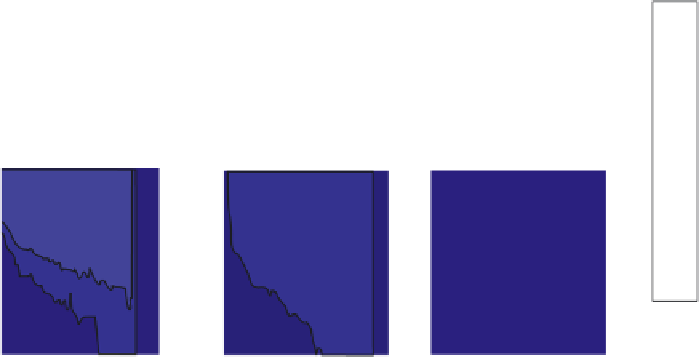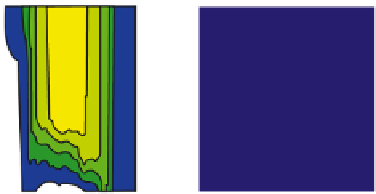Geoscience Reference
In-Depth Information
Hälsjärvi 2004 temperature (
C)
Hälsjärvi 2005 temperature (
C)
Hälsjärvi 2006 temperature (
C)
0
0
0
1
1
1
2
2
2
0
2
4
6
8
10
12
14
16
18
20
22
24
26
28
3
3
3
4
4
4
5
5
5
Apr May Jun Jul Aug Sep Oct Nov
Apr May Jun Jul Aug Sep Oct Nov
Apr May Jun Jul Aug Sep Oct Nov
Valkea-Kotinen 2004 temperature (
C)
V
a
lkea-Kotinen 2005 temperature (
C) Valkea-Kotinen 2006 temperature (°C)
0
0
0
1
1
1
2
2
2
3
3
3
4
4
4
5
5
5
6
6
Apr May Jun Jul Aug Sep Oct Nov
6
Apr May Jun Jul Aug Sep Oct Nov
Apr May Jun Jul Aug Sep
Oct Nov
Figure 3.9
Interpolated seasonal development of temperature in the experimental Lake
Halsjärvi (top) and the reference Lake Valkea-Kotinen (bottom) in the reference year
(2004) and in the two experimental years 2005 and 2006 (M. Forsius unpublished data,
2009).
The whole-lake mixing experiment THERMOS
Increasing average wind speed is expected to raise the input of mixing energy to
lakes. This scenario, i.e. increasing geostrophic winds due to a northward shift in
cyclone activity and a higher air surface temperature by the end of this century,
is projected for the north of Europe.
A whole-lake manipulation experiment in the small humic Lake Hälsjärvi in
Southern Finland simulated the increasing input of mixing energy and its impact
on the stratification cycle and heat balance of the lake (M. Forsius unpublished data,
2009). A submerged propeller caused the thermocline to deepen by about 2 m
during two summer periods in 2005 and 2006 compared with the reference years
and the nearby reference lake Valkea-Kotinen (Fig. 3.9).
The observed deepening of the thermocline in Lake Hälsjärvi corresponds to
modelled impacts on the lake thermal regime under the A2 SRES emission
scenario. Simulations with the MyLake model (Multi-year Lake simulated model;
Saloranta & Andersen 2007) simulated an increase in the mean heat content of
about 9.5 MJ m
−3
, which is equivalent to an increase in the average water
temperature by 2.3°C in summer and early autumn compared with the reference
period 1961-90 (Saloranta
et al
. 2009). The increased mean heat content in the
manipulation experiment was about 11 MJ m
−3
(equivalent to a 2.6°C increase in
the water mass temperature) in the same period, indicating that the lake
manipulation experiment well represented the mean simulated future increase in
heat content in the summer and autumn. A consequence of the lowered

















































































































































































































Search WWH ::

Custom Search